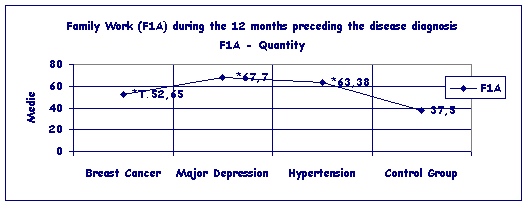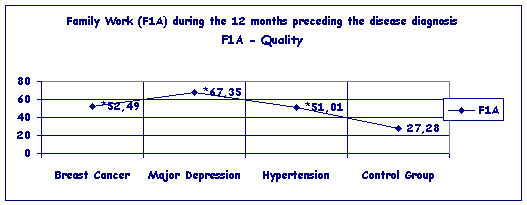 |
Family work comes up to be the risk factor common to all the groups tested: it is, then, the first psycho-social risk factor for women suffering from the pathologies studied in the research.
Italian
National Research Council
Targeted
Project " FATMA"
(Prevention and
Control of Illness Factors)
Sub-Project "Stress"
Operative Unit
ASL Naples 1 - Italy
Resp. Dr.
Elvira Reale
Experimental
research on psychological and social risk factors in female prevalent
pathologies: depression, hypertension, breast cancer.
Authors:
Elvira
Reale, doctor in philosophy and psychology
Vittoria
Sardelli, doctor in philosophy and psychology
Patrizia
Giffoni, doctor in psychology
1.
Introduction
The
aim of this research on stress is to find out significant bio-psychological and
socio-environmental risk factors in women's everyday life in order to improve
suitable prevention strategies. It
has been mainly focused, up until now, on the working conditions and has rarely
taken into consideration gender variable and family work.
According
to WHO’s data, women have more health problems than men, they live longer but
in worse psycho-physiological conditions. Women mortality is frequently caused
by: cancers (breast cancer), cardiovascular pathologies (hypertension, fatal
myocardial infarct, cerebrovascular ictus), depression with attempted and
accomplished suicides (see: Highlights on Women’s Health in Europe, WHO,
1995).
In our opinion, the most important bias of the research on women's stress
is as follows:
-
The exclusion of women from the field of the research on cardiovascular
pathologies linked to productive work conditions and to the Behaviour Pattern
Type A (Coronary –prone Behaviour Pattern Type A), found out mostly in male
population, and the subsequent underestimation of cardiovascular risks in women.
- The inclusion of
women in the field of the research on psychic pathologies and particularly on
depression, overestimating specific and partial risk factors such as endogenous
(hormonal factors connected with reproductive life), psychological (submissive
and passive personality), environmental (affective losses) factors.
-
The connection between
cancer, in particular breast cancer, and depressive pathologies: the
psychological risk factors linked to the onset of depression (affective losses,
passive and submissive personality, low self-esteem) have been considered
predictor also of breast cancer.
1.1
Aims
of our research
-
To outline a new survey on risks for women, finding out possible specific
factors of stress in women's everyday life such as "working
condition": family and extra-family work.
- To
organise, in the same field of research, the interrelated psycho-social risk
factors in women's everyday life, that we have found out in our previous
clinical research (carried on by the Women Mental Health Prevention Centre of
Naples from 1981 till 1998) on 5000 women suffering from anxious-depressive
disorders.
- To
evaluate the statistical significance of these specific risk factors by
comparing a control group to a group of women suffering from different
pathologies: depression, breast cancer and hypertension.
2. Material
and methods
We have examined 160 women, aged between 25 and 54, with homogeneous life
conditions as for marital status, children, socio-economic position. 120 of
these women, who have been diagnosed one of the three stated pathologies (mayor
depression, breast cancer type 1, moderate-severe
hypertension) during the previous 6 months, have formed the experimental
sample. The other 40 women, without any past or present pathology, have formed
the control group.
All women have answered to the "Everyday Life Risk Questionnaire",
which analyses the qualitative, quantitative and perceptive aspects of their
life conditions through 7 factors: 1.
Work (family and external work); 2. Social relationships and backings; 3.
Personal interests; 4. Personal Plans;
5. Self-esteem; 6. Other’s esteem; 7.
Tiredness and perception of own psycho-physical health.
The questionnaire, has been tested on women treated at the Women Mental
Health Prevention Centre and is part of the –Scientific Products of C.N.R (the
Italian National Council Research) "FATMA" (Prevention and Control of
disease factors) Project.
2.1 Methods and data analysis
The women has been divided in three groups according to the kind of
pathologies:
1° group: women suffering from breast cancer;
2° group: women suffering from depression;
3° group: women suffering from hypertension.
The two variables, "pathology" and "work condition",
have been considered independent variables, while the seven factors have been
considered dependent variables in a multi-factorial design.
Given to the complexity and the number of comparisons, the significant
level has been fixed to 0,01.
3.
Results
The data analysis has shown what follows:
- the
studied factors differentiate all the pathologic groups from the control group (Rao’s
= 4.67; p<0,000001).
This means that all the women of experimental groups
have life conditions which significantly vary from the control group ones: in
particular, experimental groups have shown, during the year before the onset of
the pathologies, significant
variations about the 7 factors taken into consideration, which represent daily
life areas and personal conditions.
-
There is no interaction between the two independent variables
"pathology" and "work condition"; that means that the
pathological behaviour is not influenced by different work condition in women of
experimental groups (presence or absence of extra-family work).
Results shared by the experimental groups
During the year before the onset of the pathologies (depression, hypertension and breast cancer), all the experimental groups showed a significant stress rate, related
to the increasing of familiar work.
All women from pathological groups (including the ones with an external
job) show a significant increase of family work charge and/or a significant decrease
of quality in their family work.
*

Family work comes
up to be the risk factor common to all the groups tested: it is, then, the first
psycho-social risk factor for women suffering from the pathologies studied in
the research.
*p-level
< 0.01

Results varying among the 3 groups
We've found that:
1.
the “hypertension” group
showed, besides the increase of family work load, also an increase of the
extra-family work load. This group doesn't have any reduction of activities
either in the areas of personal interests and projects or in the friendship
relations.
2.
the “depression” group
showed a decrease in friendship relations, personal interests and projects and,
in addition, a reduction in self and other's esteem.
3.
the “breast cancer” group,
just as the “depression” one, showed a lowering in the extra-family
relationships and personal projects, but not in self and other's esteem.
4.
Conclusions
The research has shown how the risk factors, representing different
typologies and life styles, have a direct connection with the onset of the main
pathologies that women suffer from.
Therefore they can become “signal factors” and play an important role
in prevention strategies. Among them we highlight the increase family work as
the main risk factor common to all three pathologies; this factor has not yet
been recognized in the research on health, nor it has ever positively been
related to the frequency and the spread of women pathologies.
We want to underline that research
on women's depression has been, up untill now, conditioned by biological
and hormonal patterns:. So far, the concrete life conditions have never been
taken into account, so that it has always been impossible for women to prevent
or find out and avoid pathogen situations in everyday life. Therefore women are
lead to pharmacological treatments, which, according to WHO, turn them into the
main psycho-drugs consumers and the main psychiatric services users.
On the contrary, the results of this research
can suggest guidelines for specific prevention plans for women
and give useful information to health-care and social workers and to
women population in order to reduce psycho-drugs abuse.
References
Braunwald,
E. (1997), Heart Disease , Saunders Publish.,USA.
Brown
G. et al. (1986), Social Support, Self-esteem and Depression, Journal Psychological
Medicine; Nov. Vol. 16 (4) 813-831.
Brown
G.W., Harris T.(1978), Social origins of depression, Tavistock Publications, London.
Eysenck,
H.J. (1988), Personality and stress as casual factors in cancer and coronary healt
disease, in: Janisse, M.P. (a cura di) "Individual differences, Stress
and Health Psychology" Springer Verlag. New York, pp.129-145.
Eysenck,
H.J. (1990), Type A Behaviour and coronary heart disease: the third stage,
Journal of Social Behavior and Personality, 5 (1), 25-44.
Greenglass,
E.R.; Burke, R.J. (1988), Work and Family
Precursors of Burnout in Teachers: Sex Differences, Journal Sex-Roles, Feb.
ol. 18 (3-4) 215-229.
Haw,
M.A. (1982), Women Work and Stress: a
Review and Agenda for the Future, Journal of Health and Social Behavior,
vol. 23.
Haynes
S.G. et al. (1980), The relationship of psychosocial factors to coronary heart disease in
the Framingham Study, American Journal of Public Health, 70,133-141.
Haynes,
S.G. et al. (1980), Women, work and coronary heart disease: prospective findings from the
Framingham Heart Study, American Journal of Public Health, 70, 133-141.
Heim,
S.C.; Snyder, D.K. (1991), Predicting Depression From Marital Distress and Attributional Processes,
Journal Marital Fam Ther, V. 17
67-72.
James,
G. et al (1986), The
influence of happiness, anger and anxiety on the blood pressure of borderline
hypertensives, Psychosomatica Medicine, 48: 502-508, sept.-oct.
Lowe,
G.S.; Northcott, H.C. (1988), The impact
of Working Conditions, Social Roles, and Personal Characteristics on Gender
Differences in Distress, Journal Work and occupations, Feb. Vol. 15 (1)
55-77.
Meininger,
J.C. (1985), The validity of Type A Behavior Scales for Employed Women, Journal
Chron Disease, vol. 38, n. 5.
Miller,
P. et al. (1989), Self-esteem, Life Stress and Psychiatric Disorders, Journal of
Affective Disorders, Jul-Aug. Vol. 17 (1) 65-75.
Mosca,
L. et al. (1997), Cardiovascular Disease in Women, A Statement for Healthcare
Professionals From the American Heart Association, Circulation, Vol 96, No 7
October
OMS
(1995), Highlights on women's health in
Europe, Regional Office for Europe Sexuality and Family Planning Health of
Women and Children.
Pancheri
, P. (1988), Stress, emozioni e malattia coronarica, F. Angeli, Milano.
Parkers,
C.M., e altri (1969), Broken heart: a
statistical study of increased mortality among widowers, British Medical
Journal, i, pp. 740-743.
Paykel,
E.S. et al. (1969), Life events and Depression, Arch. Gen. Psychiatr. 21:753-760.
Piechowski,
L.D. (1992), Mental health and women's multiple roles, Journal Families in
Society, Mar. Vol. 73(3) 131-139.
Reale,
E, et al. (1982), Malattia mentale e ruolo della donna, Progetto Finalizzato CNR
Prevenzione Malattie Mentali (PMM), Il Pensiero Scientifico, Roma.
Reale,
E, et al. (1989), Atti del 1° Seminario Internazionale sul Disagio Psichico della Donna,
Progetto Finalizzato CNR: Medicina Preventiva e Riabilitativa, Roma.
Reale,
E.; Sardelli, V. (1992), Stress e condizione femminile: ampliamenti del campo di ricerca, in
La Rosa G. (a cura di) "Stress e Lavoro", Progetto Finalizzato CNR:
Prevenzione e Controllo dei Fattori di Malattia (FATMA), Sottoprogetto Stress,
Il Mulino, Bologna.
Rosenman
R.H. (1985), Biological and Psychological factors in cardiovascular disease,
Hemisphere, New York.
Rosenman,
R.H. (1985), Health consequences of anger and implications for treatment, in M.
A. Chesney & R.H. Rosenman (a cura di), "Biological and psychological
factors in cardiovascular disease", Hemisphere, New York.
Roy,
A. (1987), Five risk factors for
Depression, National Institute for Mental Health, Bethesda, Md, Br. J.
Psychiatry 150.
Zuckerman,
D.M. (1989), Stress, Self-esteem, and Mental Health: How does gender make a
difference?, in Journal Sex-Roles; Apr. Vol. 20 (7-8) 429-444.